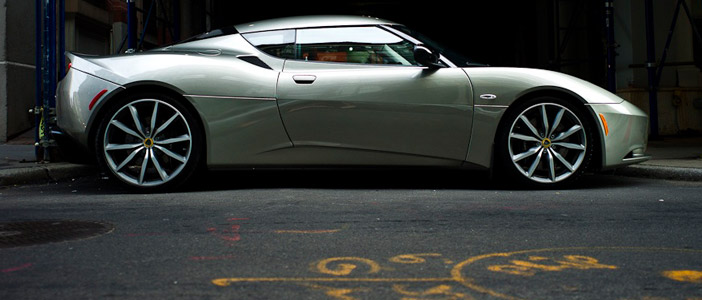First Drive: Lotus Evora S

A friend of mine once owned a Lotus Exige S. The track-ready machine was a variant of the already nimble Elise, but with a fixed roof and a big ol’ supercharger bolted onto its mid-mounted, 4-cylinder engine.
The weekend he took delivery of the car — coated in British racing green, of course — the two of us blasted out of town for some break-in miles. At one point, I asked how fast we were going. His reply: “I don’t know, the speedometer doesn’t seem to be working.”
Lotus is a quirky little company, always has been. As any enthusiast will eagerly tell you, its bantamweight track rats score off the charts in the areas of handling, acceleration, aerodynamics and lightweight construction. But the cheeky British sports cars have never quite “made it” when it comes to fit and finish. Lotuses lack the interior refinement displayed by higher-volume manufacturers like Porsche.
The Evora S, although markedly more civilized than the Elise or Exige, is not much different. Sure, there’s soft, Paprika-colored leather covering nearly every visible surface. And there are luxurious amenities one would never expect to find inside of a Lotus: heated seats, a machined-aluminum instrument panel and GPS. But you’re still riding mere inches off the ground in what’s essentially a street-legal race car — just ask my fiancée, who needed a few hours to recover from her nausea after we reached our destination. That sort of raw-edged driving dynamic might appeal to 30-year-old, car-obsessed adolescents like me, but will it hold the same appeal for a wealthy 50-year-old dude looking to add a little spice to his daily driving experience? Likely not. It’s also worth mentioning the same 50-year-old dude would need to be a contortionist to finagle himself inside the tight cockpit.
Like my buddy’s racy Exige S, the Evora S adds a supercharger and plenty of track-ready hardware to its tamer, naturally aspirated Evora sibling. Also like its Exige/Elise brethren, a Toyota-sourced engine sits amidships for superior weight distribution and handling. As is now customary with sports cars from Maranello and Germany, the engine sits beneath a layer of heat-resistant glass for you to admire and gaze upon every time you approach from behind.
The Evora employs a more powerful 3.5L V6, though, with the Harrop HTV 1320 supercharger boosting horsepower to 345 (a 69hp gain over the base Evora) and raising the torque to 295 pound-feet (a gain of 37 pound-feet). Those numbers are good enough to run you to 60 mph in a mere 4.3 seconds, six-tenths of a second faster than in the base Evora. To keep all that power in check, Lotus upgraded the six-speed gearbox with a heavier-duty clutch. On the suspension side of things, the front receives stiffer bushings and new upper wishbones for better castor angles, while the rear gets revised geometry, stiffer bushings, and a thicker antiroll bar.
